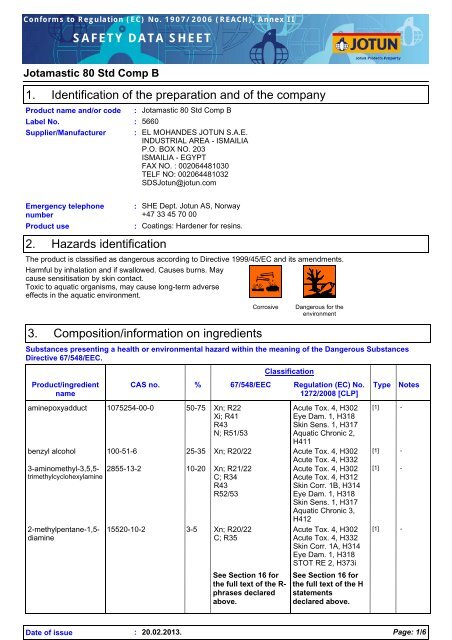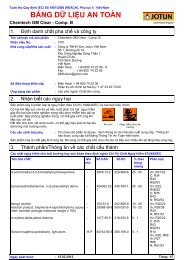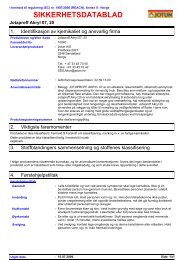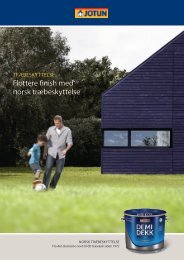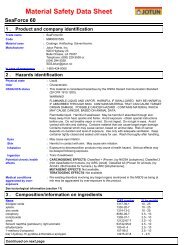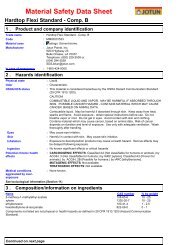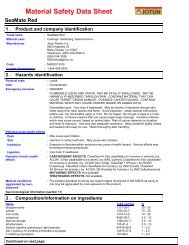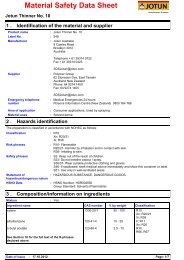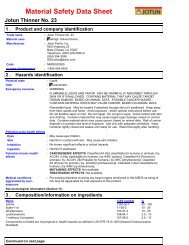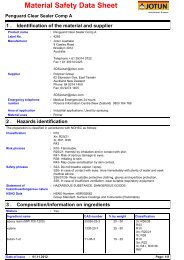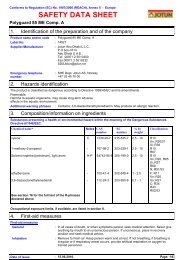Jotamastic 80 Std Comp B - Marine_Protective - English (uk ... - Jotun
Jotamastic 80 Std Comp B - Marine_Protective - English (uk ... - Jotun
Jotamastic 80 Std Comp B - Marine_Protective - English (uk ... - Jotun
- No tags were found...
Create successful ePaper yourself
Turn your PDF publications into a flip-book with our unique Google optimized e-Paper software.
Conforms to Regulation (EC) No. 1907/2006 (REACH), Annex IISAFETY DATA SHEET<strong>Jotamastic</strong> <strong>80</strong> <strong>Std</strong> <strong>Comp</strong> B1.Identification of the preparation and of the companyProduct name and/or code :<strong>Jotamastic</strong> <strong>80</strong> <strong>Std</strong> <strong>Comp</strong> BLabel No. : 5660Supplier/Manufacturer : EL MOHANDES JOTUN S.A.E.INDUSTRIAL AREA - ISMAILIAP.O. BOX NO. 203ISMAILIA - EGYPTFAX NO. : 002064481030TELF NO: 002064481032SDS<strong>Jotun</strong>@jotun.comEmergency telephonenumberProduct use2.Hazards identification::SHE Dept. <strong>Jotun</strong> AS, Norway+47 33 45 70 00Coatings: Hardener for resins.The product is classified as dangerous according to Directive 1999/45/EC and its amendments.Harmful by inhalation and if swallowed. Causes burns. Maycause sensitisation by skin contact.Toxic to aquatic organisms, may cause long-term adverseeffects in the aquatic environment.3.<strong>Comp</strong>osition/information on ingredientsaminepoxyadduct 1075254-00-0 50-75 Xn; R22Xi; R41R43N; R51/53CorrosiveDangerous for theenvironmentSubstances presenting a health or environmental hazard within the meaning of the Dangerous SubstancesDirective 67/548/EEC.Product/ingredientnameAcute Tox. 4, H302Eye Dam. 1, H318Skin Sens. 1, H317Aquatic Chronic 2,H411benzyl alcohol 100-51-6 25-35 Xn; R20/22 Acute Tox. 4, H302Acute Tox. 4, H3323-aminomethyl-3,5,5-trimethylcyclohexylamine2-methylpentane-1,5-diamineCAS no.2855-13-2 10-20 Xn; R21/22C; R34R43R52/5315520-10-2 3-5 Xn; R20/22C; R35% 67/548/EEC Regulation (EC) No. Type1272/2008 [CLP]See Section 16 forthe full text of the R-phrases declaredabove.ClassificationAcute Tox. 4, H302Acute Tox. 4, H312Skin Corr. 1B, H314Eye Dam. 1, H318Skin Sens. 1, H317Aquatic Chronic 3,H412Acute Tox. 4, H302Acute Tox. 4, H332Skin Corr. 1A, H314Eye Dam. 1, H318STOT RE 2, H373iSee Section 16 forthe full text of the Hstatementsdeclared above.[1] -[1] -[1] -[1] -NotesDate of issue : 20.02.2013.Page: 1/6
<strong>Jotamastic</strong> <strong>80</strong> <strong>Std</strong> <strong>Comp</strong> BType[1] Substance classified with a health or environmental hazard[2] Substance with a workplace exposure limit[3] Substance meets the criteria for PBT according to Regulation (EC) No. 1907/2006, Annex XIII[4] Substance meets the criteria for vPvB according to Regulation (EC) No. 1907/2006, Annex XIIIOccupational exposure limits, if available, are listed in Section 8.4.First-aid measuresFirst-aid measuresGeneralInhalationSkin contactEye contactIngestion:::::In all cases of doubt, or when symptoms persist, seek medical attention. Never giveanything by mouth to an unconscious person. If unconscious, place in recoveryposition and seek medical advice.Remove to fresh air. Keep person warm and at rest. If not breathing, if breathing isirregular or if respiratory arrest occurs, provide artificial respiration or oxygen bytrained personnel.Remove contaminated clothing and shoes. Wash skin thoroughly with soap andwater or use recognised skin cleanser. Do NOT use solvents or thinners.Check for and remove any contact lenses. Immediately flush eyes with running waterfor at least 15 minutes, keeping eyelids open. Seek immediate medical attention.If swallowed, seek medical advice immediately and show the container or label.Keep person warm and at rest. Do not induce vomiting.5.Fire-fighting measuresExtinguishing media :Extinguishing media not tobe usedRecommendationsPersonal precautionsRecommended: alcohol-resistant foam, CO2, powders, water spray.: Do not use water jet.6. Accidental release measures: Fire will produce dense black smoke. Exposure to decomposition products maycause a health hazard. Appropriate breathing apparatus may be required.Cool closed containers exposed to fire with water. Do not release runoff from fire todrains or watercourses.:Exclude sources of ignition and ventilate the area. Avoid breathing vapour or mist.Refer to protective measures listed in sections 7 and 8.Spill: Contain and collect spillage with non-combustible, absorbent material e.g. sand,earth, vermiculite or diatomaceous earth and place in container for disposalaccording to local regulations (see section 13). Preferably clean with a detergent.Avoid using solvents.Note: see section 8 for personal protective equipment and section 13 for waste disposal.7.Handling and storageHandling:Prevent the creation of flammable or explosive concentrations of vapours in air andavoid vapour concentrations higher than the occupational exposure limits.In addition, the product should only be used in areas from which all naked lights andother sources of ignition have been excluded. Electrical equipment should beprotected to the appropriate standard.To dissipate static electricity during transfer, earth drum and connect to receivingcontainer with bonding strap. Operators should wear antistatic footwear and clothingand floors should be of the conducting type.Keep away from heat, sparks and flame. No sparking tools should be used.Avoid contact with skin and eyes. Avoid the inhalation of dust, particulates, spray ormist arising from the application of this preparation. Avoid inhalation of dust fromsanding.Eating, drinking and smoking should be prohibited in areas where this material ishandled, stored and processed.Put on appropriate personal protective equipment (see Section 8).Never use pressure to empty. Container is not a pressure vessel.Always keep in containers made from the same material as the original one.<strong>Comp</strong>ly with the health and safety at work laws.Information on fire and explosion protectionVapours are heavier than air and may spread along floors. Vapours may formDate of issue : 20.02.2013.Page: 2/6
<strong>Jotamastic</strong> <strong>80</strong> <strong>Std</strong> <strong>Comp</strong> Bexplosive mixtures with air.When operators, whether spraying or not, have to work inside the spray booth,ventilation is unlikely to be sufficient to control particulates and solvent vapour in allcases. In such circumstances they should wear a compressed air-fed respiratorduring the spraying process and until such time as the particulates and solventvapour concentration has fallen below the exposure limits.Storage:Store in accordance with local regulations.Notes on joint storageKeep away from: oxidising agents, strong alkalis, strong acids.Additional information on storage conditionsObserve label precautions. Store in a dry, cool and well-ventilated area. Keep awayfrom heat and direct sunlight. Keep away from sources of ignition. No smoking.Prevent unauthorised access. Containers that have been opened must be carefullyresealed and kept upright to prevent leakage.8. Exposure controls/personal protectionEngineering measures:Provide adequate ventilation. Where reasonably practicable, this should be achievedby the use of local exhaust ventilation and good general extraction. If these are notsufficient to maintain concentrations of particulates and solvent vapours below theOEL, suitable respiratory protection must be worn.Personal protective equipmentRespiratory system :Skin and body:Hands:If workers are exposed to concentrations above the exposure limit, they must useappropriate, certified respirators. Use respiratory mask with charcoal and dust filterwhen spraying this product.(as filter combination A2-P2). In confined spaces, usecompressed-air or fresh-air respiratory equipment. When use of roller or brush,consider use of charcoalfilter.Personnel should wear antistatic clothing made of natural fibres or of hightemperature-resistantsynthetic fibres.For prolonged or repeated handling, use the following type of gloves: gloves: nitrile.Eyes:Barrier creams may help to protect the exposed areas of the skin but should not beapplied once exposure has occurred.For right choice of glove materials, with focus on chemical resistance and time ofpenetration, seek advice by the supplier of chemical resistant gloves.The user must check that the final choice of type of glove selected for handling thisproduct is the most appropriate and takes into account the particular conditions ofuse, as included in the user's risk assessment.Use safety eyewear designed to protect against splash of liquids.9.Physical and chemical propertiesPhysical stateOdourColourFlash point::::Liquid.Characteristic.Yellowish-brown.Closed cup: <strong>80</strong>°C (176°F)Density : 1.04 g/cm 3Explosion limits : 1.2 - 13%Solubility: Insoluble in the following materials: cold water and hot water.10.Stability and reactivityStable under recommended storage and handling conditions (see section 7).Hazardous decomposition products: carbon monoxide, carbon dioxide, smoke, oxides of nitrogen.Keep away from the following materials to prevent strong exothermic reactions: oxidising agents, strong alkalis, strongacids.Date of issue : 20.02.2013.Page: 3/6
<strong>Jotamastic</strong> <strong>80</strong> <strong>Std</strong> <strong>Comp</strong> B11.Toxicological informationThere are no data available on the preparation itself. The preparation has been assessed following the conventionalmethod of the Dangerous Preparations Directive 1999/45/EC and classified for toxicological hazards accordingly. Seesections 2 and 15 for details.Exposure to component solvent vapour concentrations in excess of the stated occupational exposure limit may result inadverse health effects such as mucous membrane and respiratory system irritation and adverse effects on the kidneys,liver and central nervous system. Solvents may cause some of the above effects by absorption through the skin.Symptoms and signs include headache, dizziness, fatigue, muscular weakness, drowsiness and, in extreme cases, lossof consciousness. Repeated or prolonged contact with the preparation may cause removal of natural fat from the skin,resulting in non-allergic contact dermatitis and absorption through the skin. If splashed in the eyes, the liquid may causeirritation and reversible damage. Swallowing may cause nausea, diarrhoea, vomiting, gastro-intestinal irritation andchemical pneumonia.Contains aminepoxyadduct, 3-aminomethyl-3,5,5-trimethylcyclohexylamine. May produce an allergic reaction.Corrosive to eyes and skin.Vapour may be irritating to eyes and respiratory system.Harmful if ingested.Material iscorrosive to the mucous membranes.12.Ecological informationThere are no data available on the preparation itself.Do not allow to enter drains or watercourses.The preparation has been assessed following the conventional method of the Dangerous Preparations Directive1999/45/EC and is classified for eco-toxicological properties accordingly. See Sections 3 and 15 for details.Aquatic ecotoxicityProduct/ingredient name Test ResultSpeciesaminepoxyadduct - Acute EC50 8,1 mg/l Algae -Pseudokirchneriellasubcapitata- Acute EC50 5,7 mg/l Daphnia -Daphnia3-aminomethyl-3,5,5-trimethylcyclohexylamineEcological informationBiodegradabilityProduct/ingredient name Aquatic half-life Photolysis Biodegradabilityaminepoxyadduct - - Not readilybenzyl alcohol - - Readily3-aminomethyl-3,5,5-trimethylcyclohexylamine- - Not readilyBioaccumulative potentialmagna- Acute LC50 7,9 mg/l Fish - Trout -OncorhynchusMykissIntoxication Acute EC50 17,4 to 21,5mg/L Fresh waterDaphnia -Water flea -Daphniamagna -
<strong>Jotamastic</strong> <strong>80</strong> <strong>Std</strong> <strong>Comp</strong> B13.Disposal considerationsDo not allow to enter drains or watercourses. Material and/or container must be disposed of as hazardous waste.European waste catalogue(EWC):08 01 11* Waste paint and varnish containing organic solvents or other dangeroussubstances. If this product is mixed with other wastes, this code may no longer apply.If mixed with other wastes, the appropriate code should be assigned. For furtherinformation, contact your local waste authority.14.Transport informationTransport within user’s premises: always transport in closed containers that are upright and secure. Ensure thatpersons transporting the product know what to do in the event of an accident or spillage.International transport regulationsProper shipping name<strong>Marine</strong> pollutant::Polyamines, liquid, corrosive, n.o.s. (3-aminomethyl-3,5,5-trimethylcyclohexylamine)aminepoxyadductsubstancesUN Number : 2735Class : 8Packing group: IIILabel:MarkingAdditional informationADR / RIDIMDG: The environmental hazardous / marine pollutant mark is only applicable for packagescontaining more than 5 litres for liquids and 5 kg for solids.: Tunnel restriction code: (E)Hazard identification number: <strong>80</strong>: Emergency schedules (EmS): F-A, S-B<strong>Marine</strong> pollutant: Yes.Transport in accordance with ADR/RID, IMDG/IMO and ICAO/IATA and national regulation.15.Regulatory informationEU regulationsHazard symbol or symbols: The product is classified and labelled for supply in accordance with the Directive1999/45/EC as follows::CorrosiveDangerous for theenvironmentRisk phrasesSafety phrasesContains:::R20/22- Harmful by inhalation and if swallowed.R34- Causes burns.R43- May cause sensitisation by skin contact.R51/53- Toxic to aquatic organisms, may cause long-term adverse effects in theaquatic environment.S23- Do not breathe vapour / spray.S26- In case of contact with eyes, rinse immediately with plenty of water and seekmedical advice.S36/37/39- Wear suitable protective clothing, gloves and eye/face protection.S45- In case of accident or if you feel unwell, seek medical advice immediately(show the label where possible).S51- Use only in well-ventilated areas.aminepoxyadductbenzyl alcohol3-aminomethyl-3,5,5-trimethylcyclohexylamine2-methylpentane-1,5-diamineDate of issue : 20.02.2013.Page: 5/6
<strong>Jotamastic</strong> <strong>80</strong> <strong>Std</strong> <strong>Comp</strong> BIndustrial use16. Other informationCEPE Classification : 1Full text of abbreviated HstatementsFull text of abbreviated Rphrases: The information contained in this safety data sheet does not constitute the user’sown assessment of workplace risks, as required by other health and safetylegislation. The provisions of the national health and safety at work regulations applyto the use of this product at work.: H302 Harmful if swallowed.H312 Harmful in contact with skin.H314 Causes severe skin burns and eye damage.H317 May cause an allergic skin reaction.H318 Causes serious eye damage.H332 Harmful if inhaled.H373i May cause damage to organs through prolonged or repeated exposure ifinhaled.H411 Toxic to aquatic life with long lasting effects.H412 Harmful to aquatic life with long lasting effects.: R22- Harmful if swallowed.R20/22- Harmful by inhalation and if swallowed.R21/22- Harmful in contact with skin and if swallowed.R34- Causes burns.R35- Causes severe burns.R41- Risk of serious damage to eyes.R43- May cause sensitisation by skin contact.R51/53- Toxic to aquatic organisms, may cause long-term adverse effects in theaquatic environment.R52/53- Harmful to aquatic organisms, may cause long-term adverse effects in theaquatic environment.This Safety Data Sheet is prepared in accordance with Annex II to Regulation (EC) No 1907/2006.Date of issue : 20.02.2013.Version : 2Notice to readerThe information in this SDS is based on the present state of our knowledge and on current laws. The productis not to be used for purposes other than those specified under section 1 without first obtaining writtenhandling instructions. It is always the responsibility of the user to take all necessary steps to fulfil thedemands set out in the local rules and legislation. The information in this SDS is meant to be a description ofthe safety requirements for our product. It is not to be considered a guarantee of the product's properties.Date of issue : 20.02.2013.Page: 6/6


